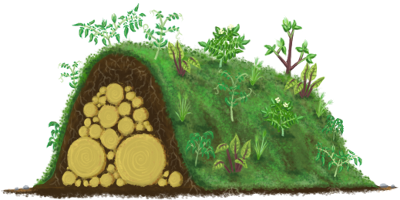Sometimes when you are just starting out with a compost pile it is hard to know just what you should put in there. We've done some research on the best items for your compost pile.
Things you CAN compost:
100% Cotton non-dyed Clothes - cut into small pieces
100% Wool Clothing- cut into small pieces
Barnyard Animal Manures - bury well in your compost to avoid flies. Do not use pet or human waste in your compost.
Beer
Brown Boxes - shredded/torn
Brown Packing Tubes - shredded/torn
Brown Paper Shopping Bags
Burlap Sacks - shredded/torn
Cereal - stale
Christmas Tree - should be chopped up very well, preferable with a wood chipper
Coffee Grounds
Coffee Filters
Corn Husks
Cotton based tissues, napkins, and paper towels
Crackers - stale saltines
Crepe Paper Streamers
Dead Leaves -
not from diseased plants
Dried Grass
Dust Bunnies
Egg Cartons - the PAPER ones
Egg Shells - need to be mashed into a fine powder
Fall Leaves
Feathers
Fish Parts/Seafood Scraps - best for large piles so they can be buried well
Floor Sweepings
Flowers from floral arrangements
Fresh Cut Grass
Fruit
Fruit Peelings
Hay
Herbs & Spices that are old
Jack o'Lanterns
Jelly, Jam, or Preserves that are old
Kelp
Kitchen Scraps
Laundry Lint (
not fabric softener sheets)
Loofahs - the natural ones
not synthetic - shredded/torn
Nut Shells -
not walnut those can be toxic to plants
Oatmeal
Old Bread
Paper
Paper plates - be sure there is no waxy coating on them
Pasta leftovers - must be plain and cooked
Pencil Shavings
Pickles
Plant Prunings -
not from diseased plants
Pine Needles
Pizza Box - shredded/torn
Pizza Crusts - tear into small pieces and bury well in the pile
Popcorn Kernels
Potpourri - ONLY natural
Pretzels - stale
Rice leftovers - must be plain and cooked
Sawdust - from untreated lumber
Seaweed
Shredded Newspaper
Soy/Almond/Rice milk
Spent Flower Blooms
Straw
Tea Leaves/grounds/bags
Tofu/Tempah
Toilet Paper & Paper Towel Rolls - shredded/torn
Trimmings from electric razor
Twigs - old & dry need to broken into small pieces
Vegetables
Vegetable Peelings
Wine
Wine Corks
Wood Ashes - in small amounts
Wood Chips
Wrapping Paper Rolls - shredded/torn
Wreaths - ONLY natural
Don't forget, Red Hill General Store carries
composting equipment and tools.




















